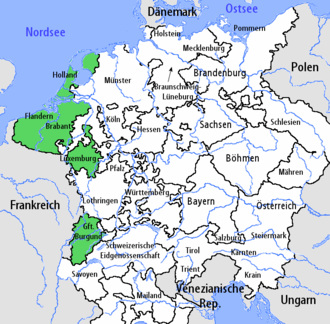Burgundian Empire

Green: the Burgundian imperial circle .

The Burgundian Imperial Circle is one of the ten Imperial Circles into which the Holy Roman Empire was divided under Emperor Maximilian I in 1500 and 1512.
It mainly comprised the possessions inherited from the House of Burgundy by the Habsburgs in the west of the empire, which were collectively referred to as the Duchy of Burgundy , as well as a few other small dominions.
The district consisted of two spatially clearly separated parts, the Free County of Burgundy in the south and the so-called Burgundian Netherlands in the north. The latter largely coincide with today's states of the Netherlands , Belgium and Luxembourg . Exceptions are the Belgian provinces of Liege and Limburg , which from the Lower Rhenish-Westphalian Circle belonging to the Bishopric of Liege emerged.
In the 17th century, as a result of the independence of the northern Netherlands and the expansion of France under Louis XIV .
Members and Territory Development
Early 16th century
In 1512 belonged to the Burgundian Empire:
- Duchy of Burgundy
-
 Free County of Burgundy with the
Free County of Burgundy with the
-
 Artois county
Artois county
-
 County of Flanders and South Flanders (around Lille )
County of Flanders and South Flanders (around Lille ) -
 Reign of Mechlin
Reign of Mechlin
-
 Namur county
Namur county
-
 Hainaut county
Hainaut county
-
 County Zealand
County Zealand
-
 County of Holland
County of Holland
-
 Duchy of Brabant together with
Duchy of Brabant together with
-
 Duchy of Luxembourg
Duchy of Luxembourg
-
 Dominion Friesland
Dominion Friesland
-
 since 1521 also Tournai
since 1521 also Tournai
-
-
Lordship of Breda ; Owner Nassau -Breda, since 1538 Nassau- Orange
-
 County of Hoorn
County of Hoorn
-
 County of Egmond and IJsselstein
County of Egmond and IJsselstein
-
Reign of Bergh
Burgundian treaty and attack on Spain
Since the leading social groups in these areas were largely alienated from the Reich, the Burgundian Treaty was concluded in 1548 at the Reichstag in Augsburg , according to which the district was largely withdrawn from the sovereignty of the Reich (for example in judicial matters), but the Reich enjoyed continuous "protection and umbrella ”of the same, while the Burgundian Circle was to pay as much as two electors in exchange for imperial allocations and as much as three electors during the Turkish wars . In addition, other areas that had previously been assigned to the Lower Rhine-Westphalian Imperial Circle and which had now come to the Habsburgs were incorporated into the district as part of the Duchy of Burgundy:
-
 Duchy of Geldern along with the
Duchy of Geldern along with the
-
Reign of Utrecht
-
 Lordship of Groningen
Lordship of Groningen
-
 Lordship of Overijssel and Drente
Lordship of Overijssel and Drente
-
 Rule of Jever as a fiefdom of Brabant until 1588, before and later independent
Rule of Jever as a fiefdom of Brabant until 1588, before and later independent
In 1556, Emperor Charles V , who was also in possession of Burgundy (i.e. the Burgundian Netherlands and the Free County of Burgundy ), abdicated and decreed that the territories should fall to his son Philip II and thus to the Spanish line of the Habsburgs. This was referred to as the Spanish Netherlands .
Independence of the Northern Netherlands
1567 began the revolt of the Netherlands against Spain, in 1568 the Eighty Years 'War , at the end of 1648 - the end of the Thirty Years' War - the northern areas as an independent Republic of the United Netherlands finally dropped out of county and kingdom and additionally northern Flanders , North Brabant and parts Limburgs received. Since then, the four smaller gentlemen have also no longer belonged to the circle.
Losses to France
The Peace of the Pyrenees of 1659 and the peace treaties of Aachen (1668) and Nijmegen (1678) separated the Artois and the Free County as well as parts of Flanders, later known as the French Netherlands , and the Hainaut from the district and the empire.
The Peace of Utrecht and the Rastatt Peace Treaty of 1713/14 brought the rest of the Spanish Netherlands - with the exception of the territories separated by the so-called barrier treaty - to Austria, whereupon the area was named Austrian Netherlands .
Late 18th century
At the end of the empire, the Burgundian Empire consisted of Mechlin, Luxembourg, Austrian Geldern , Hainaut, Flanders, Tournai, Namur and Brabant, along with Antwerp and Limburg, with the majority of these territories being considerably smaller than in 1512. The approximately 25,880 km² area with over 1.5 million inhabitants was ceded to France in the Peace of Campo Formio in 1797.
Function as the executive body of the empire
One of the most important tasks of the 10 imperial districts was the enforcement of imperial court judgments. In 1791, the Imperial Court of Justice in Wetzlar asked the Gubernium of the Austrian Netherlands to put down the Liège uprising , as the Lower Rhine-Westphalian District, which is adjacent to the Burgundian District and to which the Prince Diocese of Liège belonged, failed to meet its execution obligations. The Austrian troops who helped the fallen prince bishop back to power, occurred in the territory as "Burgundian Circle troops to".
literature
- Winfried Dotzauer: The German Imperial Circles (1383-1806). History and file edition. Franz Steiner, Stuttgart 1998, ISBN = 3-515-07146-6, pp. 390-440 ( preview on Google Books ).
- Gerhard Köbler : Historical lexicon of the German countries. The German territories from the Middle Ages to the present. 7th, completely revised edition. CH Beck, Munich 2007, ISBN 978-3-406-54986-1 .
- Contemporary representation
- Ignaz de Luca: Geographical Handbook of the Austrian State. Volume 5, 2 section: Burgundy, Lombardy, and Toscana. Joseph V. Degen, Vienna 1792, chapter The Austrian Netherlands, or the Burgundian Circle , pp. 369-580 ( digitized from Google Books , there the entire volume 5).
